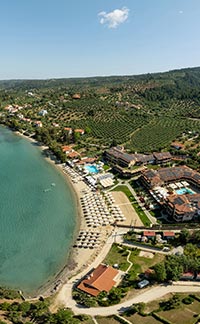Halkidiki is the northern Greek three-fingered peninsula growing out of a larger peninsula jutting south into the Aegean Sea, rather like a hand missing its thumb and pinkie. It is easily the most popular holiday destination in Northern Greece, and a special favorite of locals from Thessaloniki, about 100 km to the west. That it is less-well known as a tourist destination outside of Greece speaks well of it- a rule of thumb for travel is to go where the locals go, and Halkidiki is heavily visited by locals.
But here's the catch: only two, and about one quarter of the third, fingers are open to all visitors. The southern three-quarters of the third, most easterly finger will admit male visitors exclusively, and that by appointment only. In fact, this part of the region is not even part of Halkidiki. It is its own autonomous state.
Mount Athos, or Agion Oros (the Holy Mountain) has been closed to women since its founding as a sanctuary dedicated to the Virgin Mary in 800 AD. It's home to about 2,000 ascetic monks in 20 monasteries connected to each other by foot paths. What the monks cannot fabricate or grow themselves comes to them from the outside world by boats. It is a fascinating place to visit- but only if you are male. Visitors are given free lodging and simple meals, and are invited to join the local monks in worship services.
Some monasteries resemble medieval fortresses. Some are so large they are like small cities. They rise up out of the uncut forests, or from outcrops as if they had been pushed, fully formed, out of the living rock. Others, closer to the water, are half-hidden by the mists in the morning or evening. The sole goal of the monks on Athos is to get closer to God. Almost all of them would never leave, even for a day. They grow their own food, mend their own clothes, and celebrate hundreds of liturgies a day.
They have their own doctor, himself a monk, but because of the Spartan life on Athos and the excellent, simple diet, few people get sick. Very little heart disease, cancer or Alzheimer's afflicts these monks. They eat two, 10-minute meatless meals a day. Sometimes they have fish. While they eat a monk reads from a sacred text. The monks completely ignore the goings on in the outside world. There are no papers, television or internet on the peninsula.
The monks of Athos, as part of their desire to be close to God, not only ignore the outside world, but try to forget their past lives as well. They take the Pauline injunction to "pray without ceasing" literally, and their lips move constantly as they go about their workday. Although one would think that the life of an ascetic monk would be an unpopular career choice, the monasteries of Athos cannot handle all of its applicants. It's a harder place to get into than Harvard. Perhaps that's partly because nothing has changed here for over a thousand years. It's probably the only inhabited place on earth that can make that claim.
While it is not a tourist destination in the classical sense, Mt. Athos is certainly worth a look.
But only if you're male.
As for the northern quarter of the peninsula, it has some very nice places to visit, including some 61 stunning beaches. We'll talk about some of the beaches, and some places in the northern part of the peninsula, as well.
Best hotels in Halkidiki
Situated 2.5 km north of the famous ancient canal of Potidea, and just 40 minutes from Thessaloniki, Portes Lithos has everything you need for an affordable, luxury getaway
Set amongst the olive groves of the eastern shore of Kassandra, the westerly most of the three fingers, Aegean Melathron offers 5-star service for some of the best prices in the region
Anthemus Sea Beach can be found about halfway down the Sithonia peninsula, the middle peninsula of Halkidiki, on 38,000 m2 of west-facing Blue Flag beachfront property known as Elia Beach














